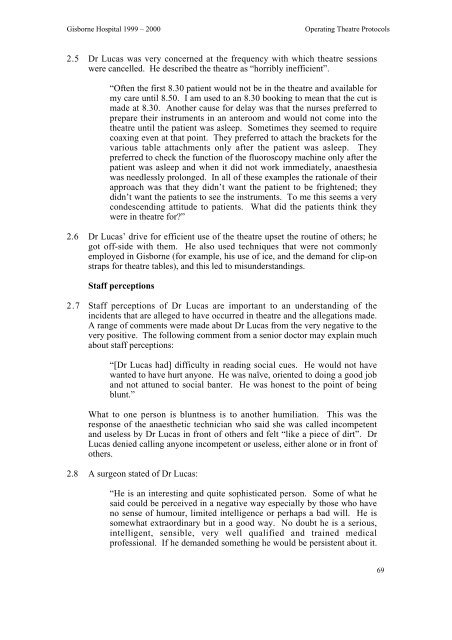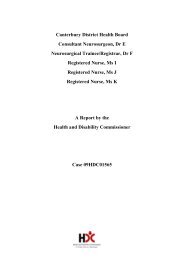Gisborne Hospital Report - Health and Disability Commissioner
Gisborne Hospital Report - Health and Disability Commissioner
Gisborne Hospital Report - Health and Disability Commissioner
Create successful ePaper yourself
Turn your PDF publications into a flip-book with our unique Google optimized e-Paper software.
<strong>Gisborne</strong> <strong>Hospital</strong> 1999 – 2000<br />
Operating Theatre Protocols<br />
2.5 Dr Lucas was very concerned at the frequency with which theatre sessions<br />
were cancelled. He described the theatre as “horribly inefficient”.<br />
“Often the first 8.30 patient would not be in the theatre <strong>and</strong> available for<br />
my care until 8.50. I am used to an 8.30 booking to mean that the cut is<br />
made at 8.30. Another cause for delay was that the nurses preferred to<br />
prepare their instruments in an anteroom <strong>and</strong> would not come into the<br />
theatre until the patient was asleep. Sometimes they seemed to require<br />
coaxing even at that point. They preferred to attach the brackets for the<br />
various table attachments only after the patient was asleep. They<br />
preferred to check the function of the fluoroscopy machine only after the<br />
patient was asleep <strong>and</strong> when it did not work immediately, anaesthesia<br />
was needlessly prolonged. In all of these examples the rationale of their<br />
approach was that they didn’t want the patient to be frightened; they<br />
didn’t want the patients to see the instruments. To me this seems a very<br />
condescending attitude to patients. What did the patients think they<br />
were in theatre for?”<br />
2.6 Dr Lucas’ drive for efficient use of the theatre upset the routine of others; he<br />
got off-side with them. He also used techniques that were not commonly<br />
employed in <strong>Gisborne</strong> (for example, his use of ice, <strong>and</strong> the dem<strong>and</strong> for clip-on<br />
straps for theatre tables), <strong>and</strong> this led to misunderst<strong>and</strong>ings.<br />
Staff perceptions<br />
2.7 Staff perceptions of Dr Lucas are important to an underst<strong>and</strong>ing of the<br />
incidents that are alleged to have occurred in theatre <strong>and</strong> the allegations made.<br />
A range of comments were made about Dr Lucas from the very negative to the<br />
very positive. The following comment from a senior doctor may explain much<br />
about staff perceptions:<br />
“[Dr Lucas had] difficulty in reading social cues. He would not have<br />
wanted to have hurt anyone. He was naïve, oriented to doing a good job<br />
<strong>and</strong> not attuned to social banter. He was honest to the point of being<br />
blunt.”<br />
What to one person is bluntness is to another humiliation. This was the<br />
response of the anaesthetic technician who said she was called incompetent<br />
<strong>and</strong> useless by Dr Lucas in front of others <strong>and</strong> felt “like a piece of dirt”. Dr<br />
Lucas denied calling anyone incompetent or useless, either alone or in front of<br />
others.<br />
2.8 A surgeon stated of Dr Lucas:<br />
“He is an interesting <strong>and</strong> quite sophisticated person. Some of what he<br />
said could be perceived in a negative way especially by those who have<br />
no sense of humour, limited intelligence or perhaps a bad will. He is<br />
somewhat extraordinary but in a good way. No doubt he is a serious,<br />
intelligent, sensible, very well qualified <strong>and</strong> trained medical<br />
professional. If he dem<strong>and</strong>ed something he would be persistent about it.<br />
69
















